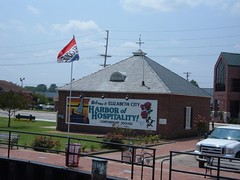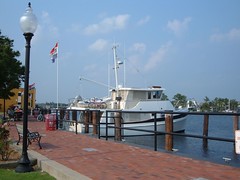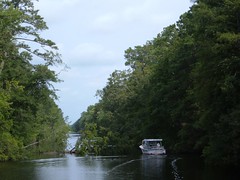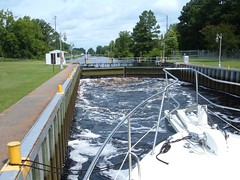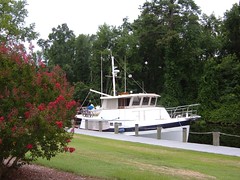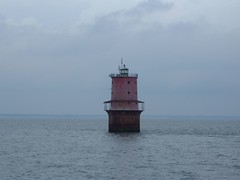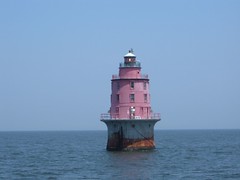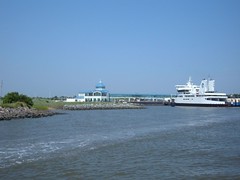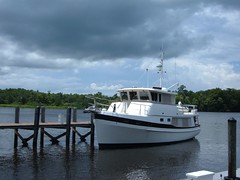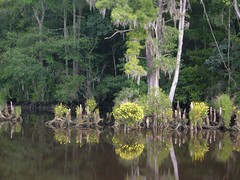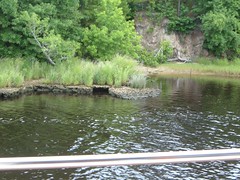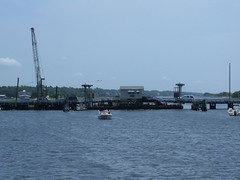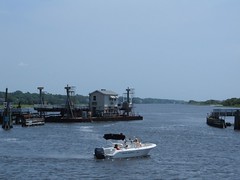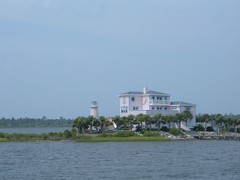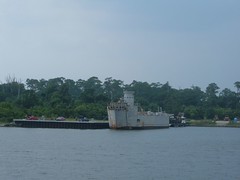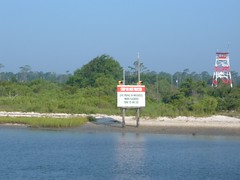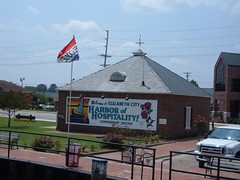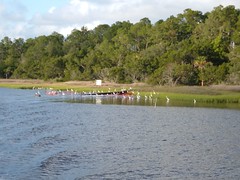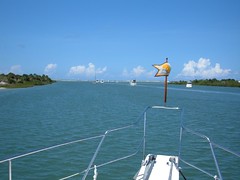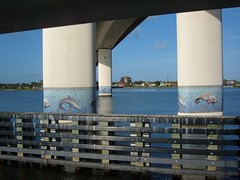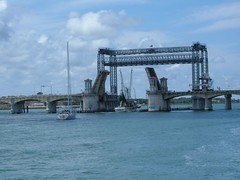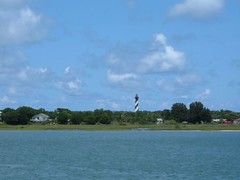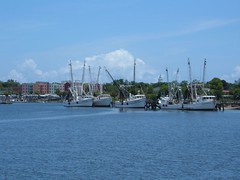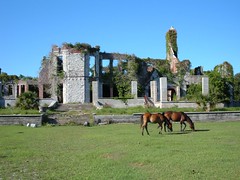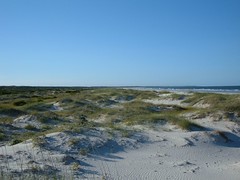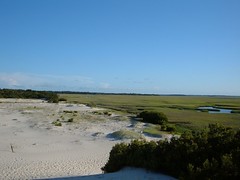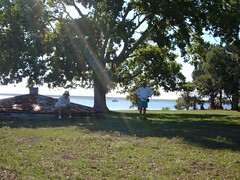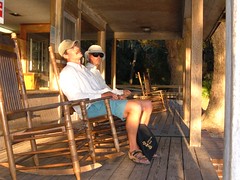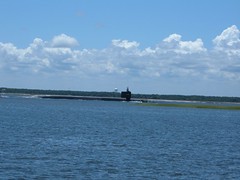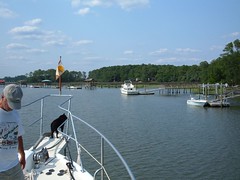WHO NEEDS PLYMOUTH ROCK?
Ask a history buff from Elizabeth City that question and they will answer “No one in Elizabeth City”. Records indicate that European explorers sailed into the waters of the Pasquotank River, Elizabeth City's waterfront, in 1585, long before the “official” landings at Jamestown and Plymouth Rock.
Today Elizabeth City is best known for its hospitality and southern charm. Many unique and architecturally fascinating buildings still exist in the Main Street Commercial District, housing boutiques and restaurants. Late 19th century homes still exist in residential areas, all visible on walking tours, with detailed maps provided by the well run Visitors Information Center.
THE WELCOMING COMMITTEE
We wondered what kind of a community we were docking into when a group of 8 people gathered to watch FLUKE back her 18' beam into an 18' slip. And they are right on top of you when you pull in, elbows on the seawall rail, wondering if the fat boat is really going to fit in that slip. Sam says it will work. Pressure is on not to look like complete boating ineptitudes. Thank you for no wind and no current, and that wonderful bow thruster. We squeeze in with minimal rubbing of the rails. Many hands offer to take the stern lines to secure FLUKE to the bulkhead. The show is over, and people go about their business. This waterfront park, right in the middle of downtown, is a popular place of recreation and relaxation for the locals. Many friendly and curious people continue to stop by throughout the next couple of days to ask questions about FLUKE and our travels.
Two regular characters to the bench off our stern I dubbed Parrotman and the Drunk. Parrotman showed up in the afternoons on a bicycle, with Pickles, his Yellowed Naped Amazon parrot, clinging to the handlebars. After propping his bike on the lamp post, PM would take Pickles over to the drinking fountain and turn the fountain on full blast and let Pickles bathe in the arcing stream of water. Then PM would place Pickles on a couple of sticks that PM had stood on his bicycle to tie high up on the lamp post. PM would sit on the bench for several hours watching the sites and talking to anyone who happened by. He always had lots of questions for me. Even Pickles would say Hi to me.
PM was one of those men, who women always joke about, that wore a mismatching plaid shirt and different type of plaid pair of shorts. Plus, he wore a stripped railroad engineer's hat. So, he and Pickles reminded me of a clown act in the circus! However, when PM spoke he was articulate, well versed on community and current events, and seemingly well-read. Talking to him was pleasant, other than he usually had more questions about life than I had, so it was difficult to be able to end a conversation with him.
The Drunk was a man of very bronzed complexion with piercing dark blue eyes – I guessed he must do some type of outside work. He showed up in late afternoon, neat and cleanly dressed, with a bag containing a bottle and sat on the same bench with PM. He was a chatterbox, but his extreme southern accent alone made understanding him somewhat difficult and as the afternoon went on and the bottle went lower his language became more difficult to understand, although he seemed happy about everything he said. When I came back from a late afternoon walk with Ursa I asked them if they wanted to see Ursa do her tricks. They were both animal lovers and readily replied “of course”. Ursa proceeded to impress them with her litany of tricks, drawing other passerbys' attentions – just like the circus I envisioned. The Drunk asked if she could shake hands with him, so I gave him a treat to give to Ursa and pulled her near to him. She succeeded, despite the slurred command (fortunately she is trained by sign too for most of her tricks, so putting his hand low was probably enough without having to hear the words). She then proceeded to jump up on his bench and take a sniff of the bottle! The Drunk quickly retracted his booty and said “I'm not sharing my bottle with a dog!”. I didn't want Ursa's lips on it anyway.
HUNTERS AND GATHERERS
We are always on the lookout for fresh produce, since it is usually a while before we have access to land to even try to find any and that's what we use first. We went on a 5 mile roundtrip bike ride to the outer part of town to visit a Walmart to pick up some computer software we couldn't find in downtown. A man was selling cantaloupes from the back of a pick-up truck, so we bought one. I had it in the basket on the front of the bike and hit a bump and the whole basket flipped off the handlebars, dumping the melon on the sidewalk. Fortunately it didn't roll out into traffic or break open. No one said the hunt would be easy. To assuage my frustration over the melon incident, we stopped at City Sweets in the old downtown and got an ice cream cone (always a favorite amongst cruisers) and a couple of hand-dipped chocolate covered strawberries. Sugar – life is good. What melon?
Having spent the majority of the afternoon away from the boat, we decided to infuse some more money into the local economy by ordering a pizza. There is free WiFi at the docks, so we thought it would be a good idea to support the pizza business that was advertising on the WiFi. Plus, they offered free delivery. I called the number and told the girl taking the order what I wanted. She said she needed a phone number, so I proceeded to tell her our cell phone number, but she said she had to have a local number. I explained that we were on a boat, to which she replied “Well, don't you know anyone in town?” I said “I've gotten to be pretty friendly with 3 old men on the dock, but they haven't given me their phone numbers”. She said she couldn't place the order without a local number and asked exactly where I was. I told her I could see the sign belonging to the restaurant next door, which she was familiar with, so she decided to use its phone number and told me she would put me on hold while she looked it up in the phone book. Just a new twist to the hunt – the pizza was great!
GETTING FROM HERE TO THERE
If you are traveling by boat and want to get from Norfolk, VA, where the Atlantic Intracoastal Waterway begins at mile 0, to North Carolina you can take one of two routes: the Dismal Swamp Canal or the Albemarle and Chesapeake Canal. The DSC is traveled primarily by recreational boaters, for reasons which will become apparent as you read further, while the ACC is used more by commercial craft, boaters in a hurry, or boaters of more careful nature. We, being of adventurous nature, decided to take the DSC route. Note: the DSC route recommends boats not draw more than 6' to safely transit the waterway; FLUKE draws 5.5'.
WARNING SIGNS
The Pasquotank River connects Elizabeth City to the south lock of the Dismal Swamp Canal. For the most part, the river is very scenic, gracefully winding with a well-marked deep water channel. The shoreline is lined with beautiful, old stands of cypress, gum, and other hardwoods and looks much like some of the swamp lands we encountered farther south. When you get closer to the DSC, a dredged, straight, narrow waterway replaces the natural river. The shoreline is not as stable as that created by Mother Nature, and the continual beating by boat wakes further adds to its instability. During the summer months a lot of vine growth covers the overhanging trees, adding even more weight to their limbs. Summer thunderstorms can bring a lot of wind and rain, enough to give precariously perched trees their final push into the river. We didn't know that when we embarked on our voyage, this the 22nd day of July 2006.
After about 2 hours, we turned off the natural course of the river and entered the straight channel. In the distance it looked like a tree was down in the water, but it was difficult to see how much it was actually obstructing the waterway. As we got closer, it was apparent the very large pine tree was newly fallen and was blocking about 90% of the waterway. Fortunately, a small local tour boat was coming up behind us. We idled down until the tour boat was at our stern and we told the captain we needed help to determine if we could get around the fallen tree. He took Eddie on board and went around the tree to determine water depth along the shoreline and to see if our pilothouse could clear the overhanging branches. Water depth was fine; we picked up a lot of debris from the overhanging limbs and only one scratch on an antenna. The tourists on the boat were thrilled to be involved in an “assistance at sea” maneuver.
We cautiously motored onward; a bald eagle swooped down across our bow and led the way around the bend to the south lock of the Dismal Swamp Canal.
THE DISMAL SWAMP CANAL
In 1728 Colonel William Byrd II of Virginia returned from a survey trip of the Dismal Swamp region. Despite, coining the area as “dismal” because he and his crew were constantly tormented by yellow flies, ticks, and chiggers, Byrd recognized the potential in being able to connect the sounds of North Carolina with the tidewater areas of Virginia to safely move goods back and forth. However, it wasn't until after the Revolutionary War that enough other people also realized the value a canal would have in helping to make the new country grow and prosper by moving goods along that north/south route.
In 1793, construction began on both ends of the canal. Since it had to be dug almost entirely by hand, using slave labor hired from nearby landowners, progress was slow and expensive. Numerous problems and other proposals to alternate routes of transportation prevented the canal from opening until 1805. When it finally opened, it was so shallow, only flat boats and log rafts could use it, and they had to be manually towed or poled through. This was a big disappointment to canal owners, farmers, lumbermen, and other merchants who had envisioned the canal as a great trade route. Maintenance costs and problems with the water levels led the canal to fall into disrepair and be sold. Private ownership continued to fail until finally in 1925 the U.S. Congress authorized purchase of the DSC. In 1974, Congress established the Great Dismal Swamp National Wildlife Refuge. Then, the water needs of the swamp took priority over the navigational needs of the canal. Today, the canal is maintained to a depth of 6'. The locks at either end of the canal keep the canal 8' above the surrounding waterways. If the water level in Lake Drummond, the main source of water for the canal falls too low, water cannot drain into the canal and the canal is shut down to transportation. The costs of maintaining the canal remain high: cleaning the bottom of the canal, maintenance of locks and bridges, and shoreline maintenance. Such costs are questionable to justify keeping the canal navigable for large cruiser type boat traffic.
THE VOTE WAS UNANIMOUS
The Welcome Station is a nice facility with lots of written literature about places to visit in NC, a NC field crop demonstration garden, and a beautiful picnic area. It is site of a 4.5 bike path that winds along the banks of the DSC to a little town called South Mills. We biked the whole loop in the late afternoon to help relieve the anxiety from the morning's travel.
Just as we returned to FLUKE a couple walked up and started up a conversation; they had been live-aboards at one time, based in the Chesapeake. They were nice enough to go over charts with us, giving us a much-needed overview of the cruising area, making useful suggestions on where we could anchor.
We got an early start the next morning, anticipating another arduous day of dodging and coasting. It turned out that the first 4 miles proved to be the worst, not that the rest were easy going. We were thankful that we didn't see another boat in the DSC the entire 2 days, as we would have had to undergo some tight maneuvers to let another boat pass by our fat gem.
If we hadn't taken the DSC I would have always wondered, and probably whined, about wanting to do it. However, having now done it, we all agreed that we will not do it again. The scenery and solitude are nice, but they are no better than several other places we have traveled this 2006 Voyage North. Plus, the risk to the boat is too great to justify that transit. One scenario that frequently crossed our minds, as we passed so many precariously perched large trees on obviously unstable banks, was what would we do if we had to pass another newly fallen tree with no one else around? It could be several days before a crew could be mobilized to move the obstruction. Then we would have no choice but to wait, through who knows how many thunderstorms or else turn around and go all the way back to Elizabeth City, with more downed trees possibly in our path. Leave the DSC for small power boats, kayaks, and canoes.
FROM NOTHING TO EVERYTHING
We passed over the Hampton Roads Bridge Tunnel and declared ourselves as having finally arrived in The Chesapeake! We cruised up to Mobjack Bay, entered into Put-in-Creek and set the anchor. The surrounding land had a few farms, single family homes of various styles and ages and lots of trees. It was peaceful and welcoming. I was mesmerized by the scores of jellyfish floating in and out of the depths all around FLUKE. Coming from FL, it was puzzling how there could be so much water and not be able to go swimming because of all the jellyfish. The next morning we waited to exit our anchorage while a crew team, with men and women rowers in 1, 2, and 4 person shells rowed by with their coach traveling in a small skiff booming out orders over a bull horn.
SO MANY CHOICES, TOO LITTLE TIME
I've been writing most of this section of the Great Voyage of 2006 while we have been underway (and I haven't had helm duty), since 5:45 a.m., leaving from the Sassafras River, just south of the C & D Canal, which connects the Chesapeake Bay to Delaware Bay. We have spent the day staying just outside the main shipping channel as large freighters and commercial ships have passed us in both directions, destinations for them could be any of several major ports accessed by this route: all of those in the Chesapeake (Baltimore, Annapolis, Norfolk), up the Potomoc, and up to Philadephia.
Our destination on this the 28th day of July 2006 is a marina in Cape May, where we will dock for the night, finally hose down FLUKE, get to do laundry, and presumably post this section to the internet for those of you who are vicariously cruising with us.
We need to get rested up for the next leg of the voyage, out to the Atlantic Ocean, into New York Harbor, and into Long Island Sound.

